1996 CHEVROLET CORVETTE ECU
[x] Cancel search: ECUPage 22 of 386

Downloaded from www.Manualslib.com manuals search engine How to Wear Safety Belts Properly
Adults
This part is only for people of adult size.
Be aware that there are special things to know about
safety belts and children. And there are different rules
for smaller children and babies. If a child will be riding
in your Corvette, see the part of this manual called
“Children.” Follow those rules for everyone’s
protection.
First, you’ll want to know which restraint systems your
vehicle has.
We’ll start with the driver position.
Driver Position
This part describes the driver’s restraint system.
Lap-Shoulder Belt
The driver has a lap-shoulder belt. Here’s how to wear it
properly.
1. Close and lock the door.
2. Adjust the seat (to see how, see “Seats” in the Index)
so you can sit up straight.
3. Pick up the latch plate and pull the belt across you.
Don’t let it get twisted.
4. Push the latch plate into the buckle until it clicks.
Pull up on the latch plate to make sure it is secure.
If the belt isn’t long enough, see “Safety Belt
Extender” at the end
of this section.
Make sure the release button on the buckle is
positioned
so you would be able to unbuckle the
safety belt quickly if you ever had to.
1-11
Page 29 of 386
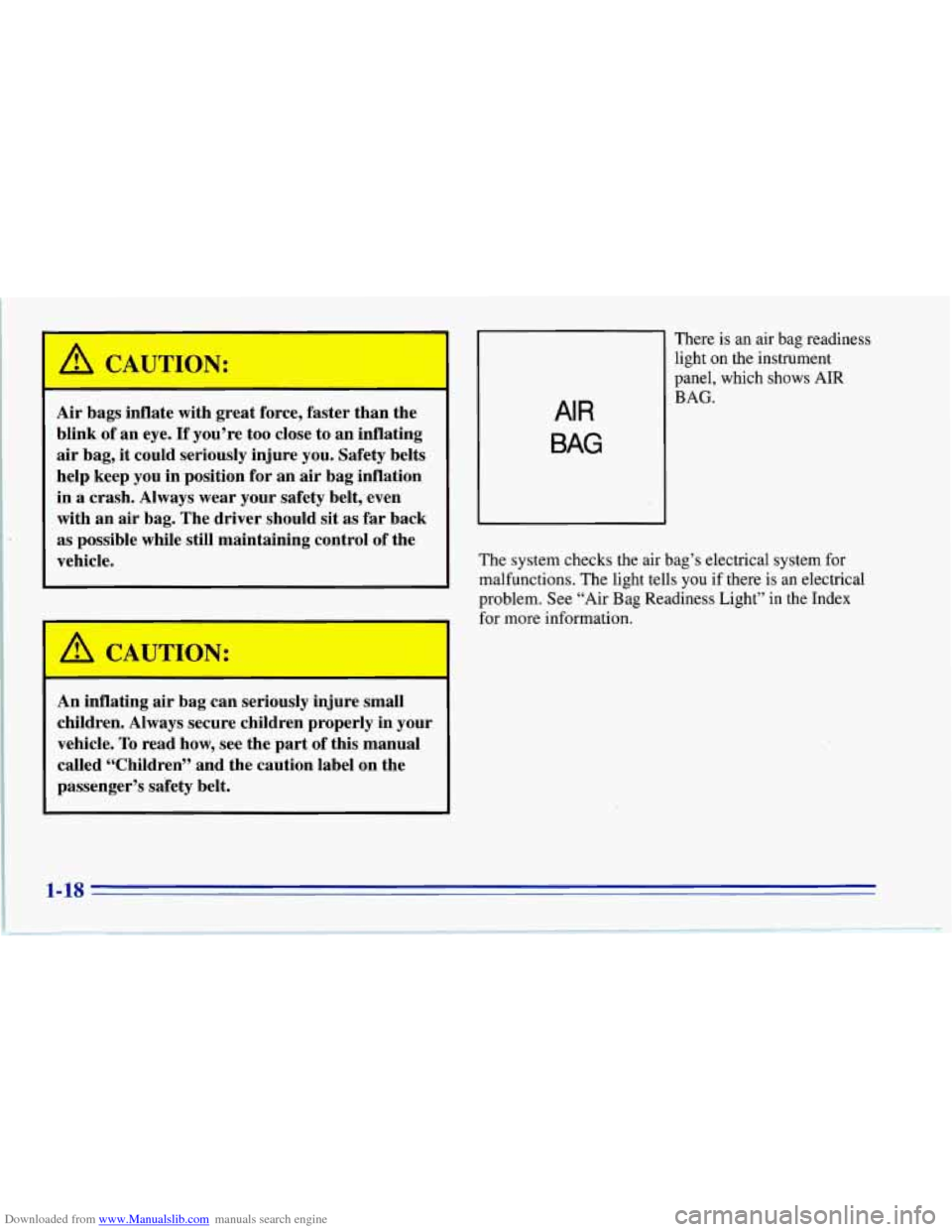
Downloaded from www.Manualslib.com manuals search engine e
Air bags inflate with great force, faster than the
blink of an eye.
If you’re too close to an inflating
air bag, it could seriously injure you. Safety belts
help keep you in position for an air bag inflation
in a crash. Always wear your safety belt, even
with an air bag. The driver should sit as
far back
as possible while still maintaining control of the
vehicle.
e
An inflating air bag can seriously injure small
children. Always secure children properly in your
vehicle.
To read how, see the part of this manual
called “Children” and the caution label on the
passenger’s safety belt.
AIR
BAG
There is an air bag readiness
light on the instrument
panel, which shows AIR
BAG.
The system checks the air bag’s electrical system for
malfunctions. The light tells you if there
is an electrical
problem. See “Air Bag Readiness Light” in the Index
for more information.
1-18
Page 37 of 386
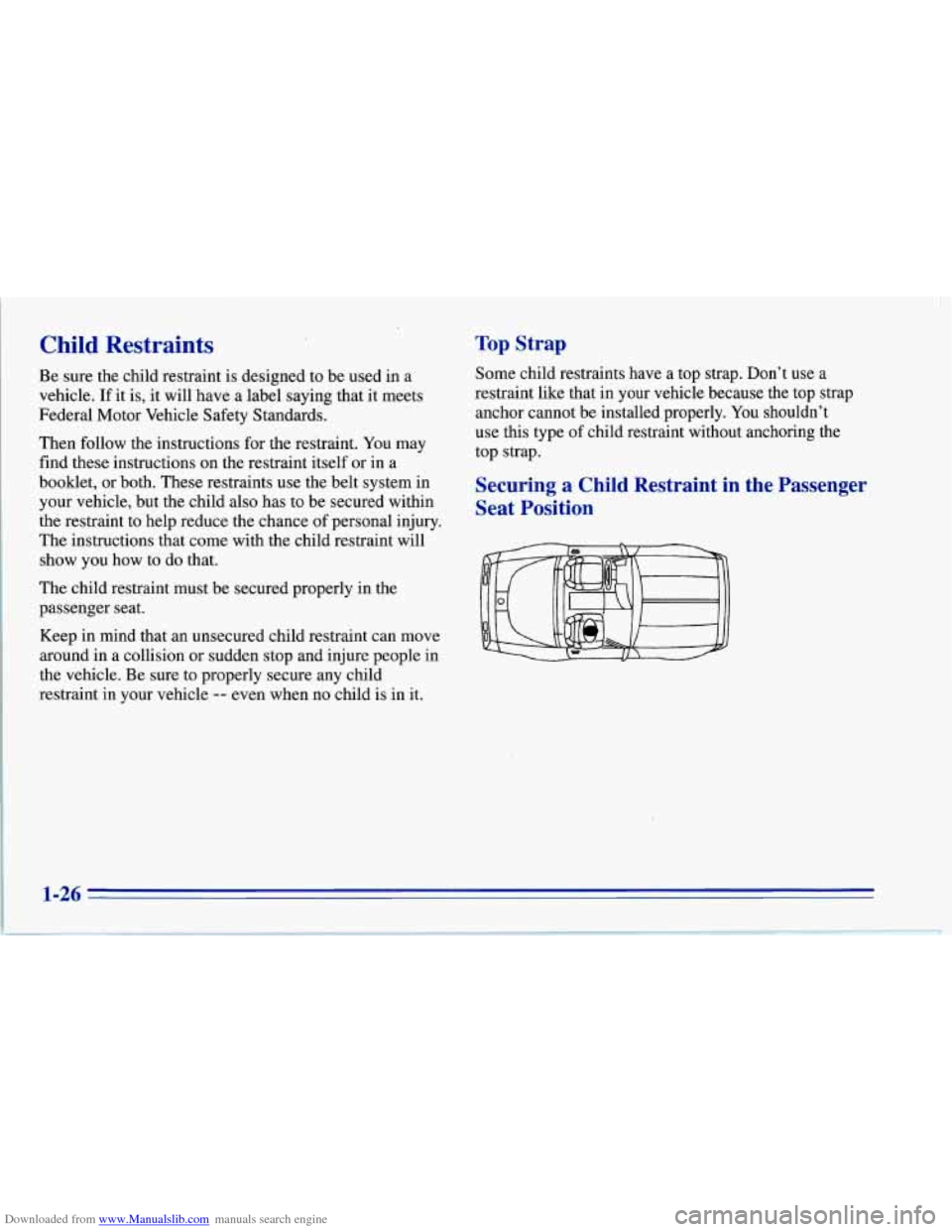
Downloaded from www.Manualslib.com manuals search engine Child Restraints Top Strap
Be sure the child restraint is designed to be used in a
vehicle.
If it is, it will have a label saying that it meets
Federal Motor Vehicle Safety Standards.
Then follow the instructions for the restraint. You may
find these instructions on the restraint itself or in a
booklet, or both. These restraints use the belt system in
your vehicle, but the child also has to be secured within
the restraint to help reduce the chance
of personal injury.
The instructions that come with the child restraint will
show you how to do that.
The child restraint must be secured properly in the
passenger seat.
Keep in mind that an unsecured child restraint can move
around in a collision or sudden stop and injure people in
the vehicle. Be sure to properly secure any child
restraint in your vehicle
-- even when no child is in it. Some
child restraints have a top strap. Don’t use a
restraint like that in your vehicle because the top strap
anchor cannot be installed properly.
You shouldn’t
use this type
of child restraint without anchoring the
top strap.
Securing a Child Restraint in the Passenger
Seat Position
1-26
Page 38 of 386

Downloaded from www.Manualslib.com manuals search engine Your vehicle has a passenger air bag. Never put a
rear-facing child restraint in this vehicle. Here’s why:
a CAW TION:
A child in a rear-facing child restraint can be
seriously injured if the passenger’s air bag
inflates. This is because the back of a rear-facing
child restraint would be very close to the inflating
air bag.
Do not use a rear-facing child restraint in
this vehicle.
If a forward-facing child restraint is suitable for
your child, always move the passenger seat as far
back as it will
go.
You’ll be using the lap-shoulder belt. See the earlier part
about the top strap
if the child restraint has one.
1. Because your vehicle has a passenger air bag, always
move the seat as far back as it will go before
securing a forward-facing child restraint. (See
“Seats” in the Index.)
2. Put the restraint on the seat. Follow the instructions
for the child restraint.
3. Secure the child in the child restraint as the
instructions say.
4. Pick up the latch plate, and run the lap and shoulder
portions of the vehicle’s safety belt through or
around the restraint. The child restraint instructions
will show you how.
If the shoulder belt goes in front of the child’s face or
neck, put it behind the child restraint.
1-27
Page 39 of 386
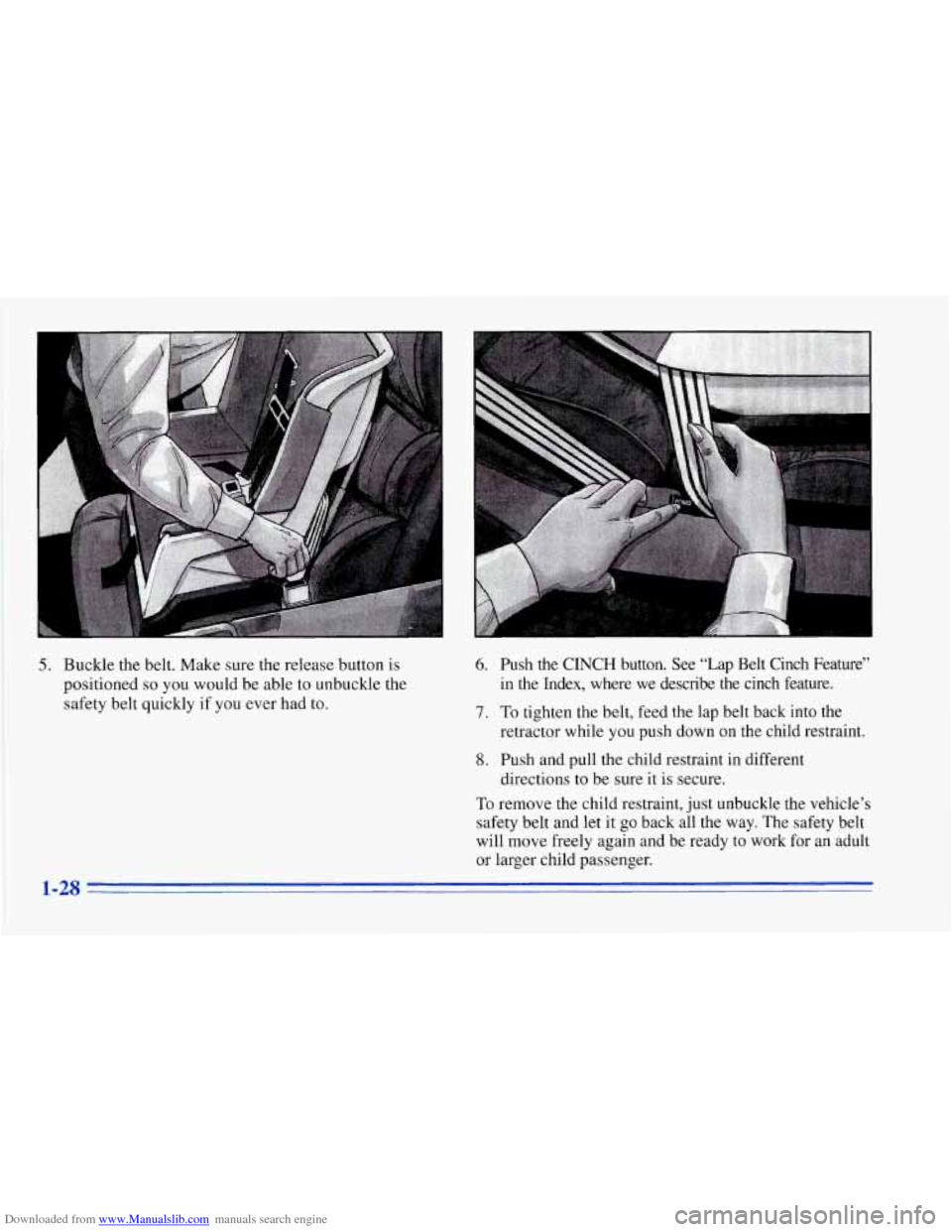
Downloaded from www.Manualslib.com manuals search engine 5. Buckle the belt. Make sure the release button is
positioned
so you would be able to unbuckle the
safety belt quickly
if you ever had to.
6. Push the CINCH button. See “Lap Belt Cinch Feature”
in the Index, where
we describe the cinch feature.
7. To tighten the belt, feed the lap belt back into the
retractor while
you push down on the child restraint,
8. Push and pull the child restraint in different
To remove the child restraint, just unbuckle the vehicle’s
safety belt and let it
go back all the way.. The safety belt
will move freely again and be ready to work for an adult
or larger child passenger. directions
to be sure
it is secure.
28
Page 53 of 386

Downloaded from www.Manualslib.com manuals search engine If you have a coupe, this
switch is on the rear
of the
driver’s door. It works with
the door open and the
transmission in any gear.
Push it down to release the
hatch.
The
PKE transmitter will also release the hatch. See
“Passive Keyless Entry System’’ in the Index.
8
I , .. .
If you don’t have battery power, use the manual release
cable to open the hatch. The cable
is near the security
shade handle, between the carpet and the shade.
2-10
Page 56 of 386
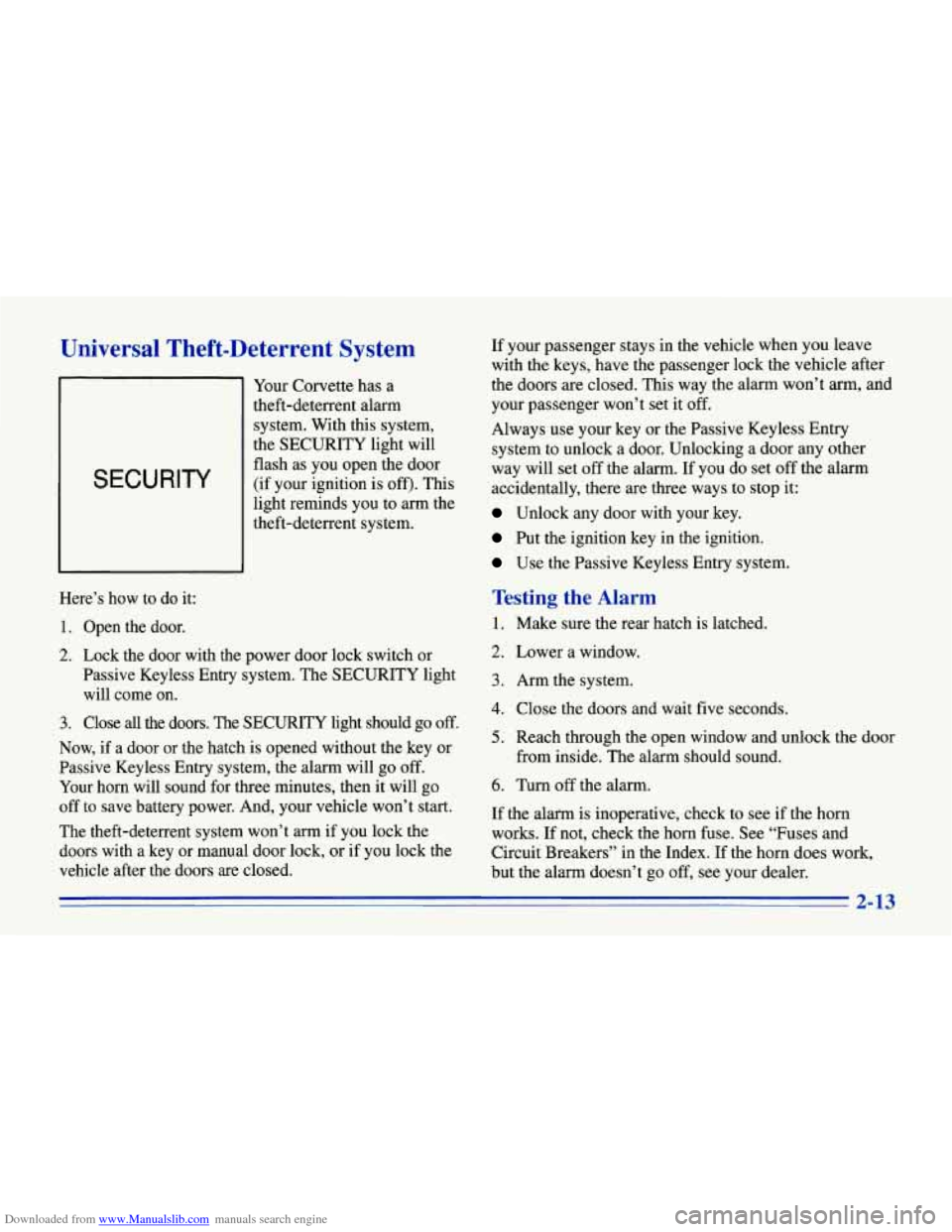
Downloaded from www.Manualslib.com manuals search engine Universal Theft-Deterrent System
SECURITY
Your Corvette has a
theft-deterrent alarm system. With this system,
the SECURITY light will
flash as you open the door
(if your ignition is off). This
light reminds you to arm the
theft-deterrent system.
Here’s how to do it:
1. Open the door.
2. Lock the door with the power door lock switch or
Passive Keyless Entry system. The SECURITY light
will come
on.
3. Close all the doors. The SECURITY light should go off.
Now, if a door or the hatch is opened without the key or
Passive Keyless Entry system, the alarm will
go off.
Your horn will sound for three minutes, then it will go
off to save battery power. And, your vehicle won’t start.
The theft-deterrent system won’t arm
if you lock the
doors with a key or manual door lock, or
if you lock the
vehicle after the doors are closed. If
your passenger stays in the vehcle when you leave
with the keys, have the passenger lock
the vehicle after
the doors
are closed. This way the alarm won’t arm, and
your passenger won’t set it off.
Always use your key
or the Passive Keyless Entry
system to unlock a door. Unlocking a door any other
way will set
off the alarm. If you do set off the alarm
accidentally, there
are three ways to stop it:
Unlock any door with your key.
Put the ignition key in the ignition.
Use the Passive Keyless Entry system.
Testing the Alarm
1.
2.
3.
4.
5.
6.
Make sure the rear hatch is latched.
Lower a window.
Arm the system.
Close the doors and wait five seconds.
Reach through the open window and unlock the door
from inside. The alarm should sound.
Turn
off the alarm.
If the alam is inoperative, check to see if the horn
works. If not, check the horn fuse. See “Fuses and
Circuit Breakers” in the Index. If the horn does work,
but the alarm doesn’t
go off, see your dealer.
2-13
Page 57 of 386
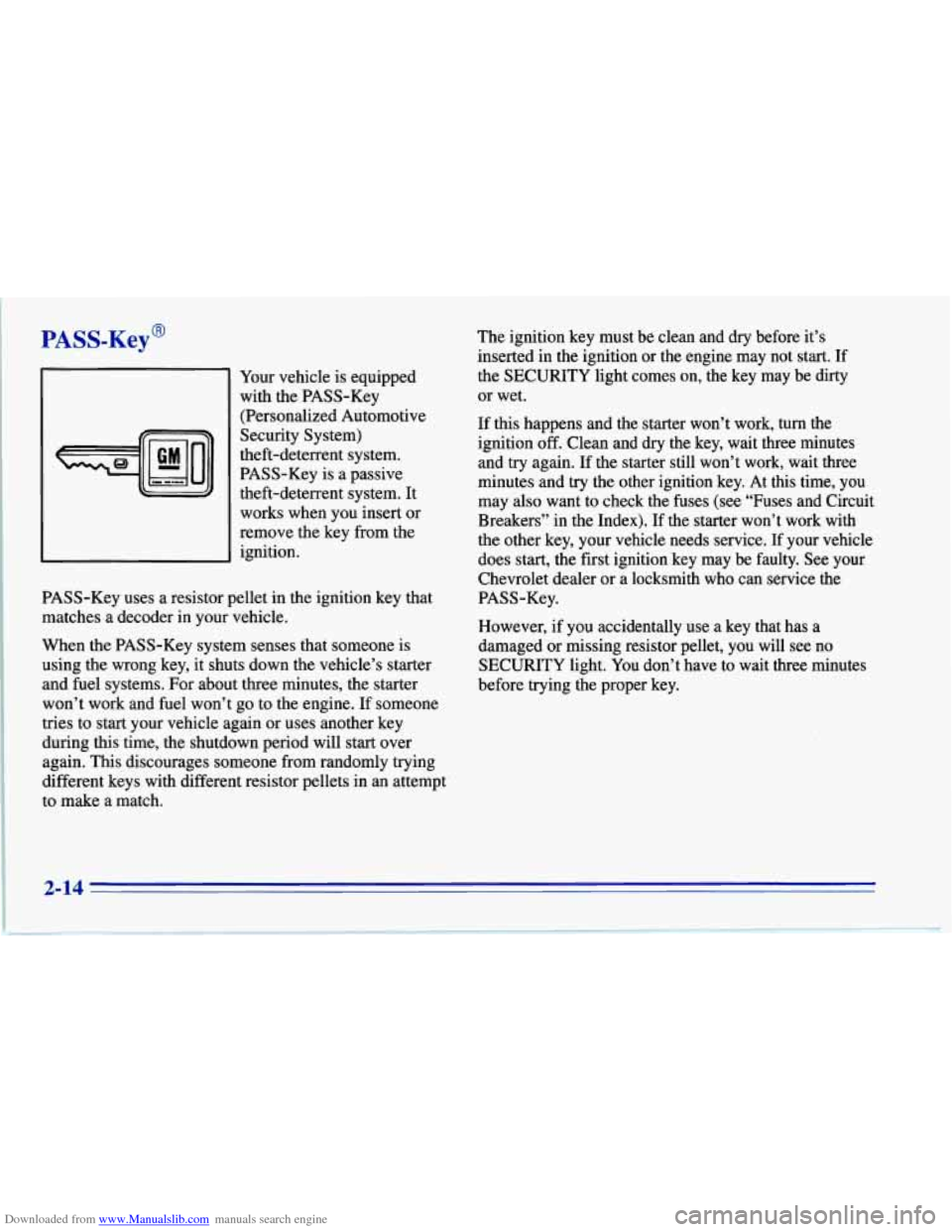
Downloaded from www.Manualslib.com manuals search engine PASS-Key@
Your vehicle is equipped
with the PASS-Key
(Personalized Automotive
Security System)
theft-deterrent system.
PASS-Key is a passive
theft-deterrent system.
It
works when you insert or
remove the key from the
ignition.
PASS-Key uses
a resistor pellet in the ignition key that
matches a decoder in your vehicle.
When the PASS-Key system senses that someone is
using the wrong key, it shuts down the vehicle’s starter
and fuel systems. For about three minutes, the starter
won’t work and fuel won’t go to the engine.
If someone
tries to start your vehicle again or uses another key
during this time, the shutdown period will start over
again. This discourages someone from randomly trying
different keys with different resistor pellets in an attempt
to make a match. The
ignition key must be clean and
dry before it’s
inserted in the ignition or the engine may not start. If
the SECURITY light comes on, the key
may be dirty
or wet.
If
this happens and the starter won’t work, turn the
ignition
off. Clean and dry the key, wait three minutes
and
try again. If the starter still won’t work, wait three
minutes and try the other ignition key. At this time, you
may also want to check the fuses (see “Fuses and Circuit
Breakers” in the Index). If the starter won’t work with
the other key, your vehicle needs service. If your vehicle
does start, the first ignition key may be faulty. See your
Chevrolet dealer or a locksmith who can service the
PASS-Key.
However, if you accidentally use a key that has a
damaged or missing resistor pellet, you will see no
SECURITY light. You don’t have to wait three minutes
before trying the proper key.
2-14
__